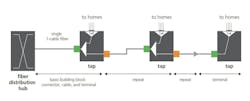TAP networks can be a higher-value FTTH architecture that makes rural deployments more feasible.
Fiber-to-the-home (FTTH) architectures are bringing new levels of connectivity to eager subscribers all over the world, and the uptake has been breathtakingly robust. In 2022 alone, 20 million new fixed broadband connections were deployed worldwide, the majority of which were made via FTTH. In fact, of the 1.38 billion fixed broadband connections in operation globally by March of 2023, fully two-thirds of them were FTTH connections.
Going forward, the new fiber frontier is the rural market, and with this sharpened focus come new challenges that didn’t exist in urban and suburban deployments of the past. For the providers who are racing to spread fiber to the furthest reaches of their service areas, it all really boils down to a single metric: feasibility—which includes a number of technological and economical components, such as ROI, total deployment costs, and average revenue per user (ARPU), among others. Optical terminal access point (TAP) architectures can make rural markets more feasible to serve.
The Challenges—and an Architectural Solution
The lower population densities of rural communities, the large variations in distance between premises, and their distance from central offices and other distribution infrastructure, have combined to keep these communities among the most frequently underserved in the nation. Simply put, the miles of required fiber and handful of customers simply do not add up into a feasible business case. At least, not until recently.
Over the last few years, the U.S. Federal Government has recognized the need to ensure all citizens are able to participate in our increasingly connected digital society, and to this end has allocated significant funding to support the deployment of broadband networks to those communities who lack reliable, high-performance connectivity. Right now, the largest component, by far, is rural connectivity. The road to closing the “digital divide” runs through these long-overlooked communities.
With more than $100 billion committed to expanding the reach of communications networks from coast to coast, service providers are getting some much-needed help in bringing the feasibility equation back into balance. Ongoing fund releases are earmarked to support rural fiber deployments, including the recent $42.45 billion allocation for the Broadband Equity, Access, and Deployment (BEAD) program under the Infrastructure Investments and Jobs Act (IIJA).
However, as large as this investment is, the task ahead is much, much larger. With millions of rural households to connect—and FTTH connection costs often ranging from $6,000 to $10,000 (or more) per house passed—it’s clear that, even with unprecedented funding levels, cost gaps exist, and service providers are expected to step up and make investments of their own. Yet, the average revenue per user in such deployments has very little wiggle room to improve, so providers must reduce upfront costs as much as possible to fulfill the federal mandate and still pursue a feasible business case.
It's in this part of the equation that TAP architecture can help expand and accelerate FTTH network deployments, by reducing the time, cost, and labor required to connect individual residences and increase the number of homes passed.
The Business Case for Optical TAP
Unlike more traditional split architectures such as centralized split, which employs one or two stages of splitters (one out of the central office or headend and the other closer to the subscriber), optical TAPs draw against the fiber cable’s optical link budget via a physical TAP splitter (See Figure 1).
The effect is that the new TAP connection siphons a portion of the signal to the connected customer yet allows the rest of the signal to continue to its next TAP connection. Indeed, this approach somewhat mimics how a coaxial part of a Hybrid Fiber Coax deployment is built.
Each TAP can serve one or more residences, extending as far out as needed until the optical link budget is exhausted or the maximum number of subscribers per optical line terminal (OLT) is reached—usually up to 32 connections, or even up to 64 where XGSPON is employed. For rural communities where passed home density can be as low as 10 homes per mile (or even less), optical TAPs can help a single fiber run to cover a vast linear distance in a remarkably economical way.
The advantages of the TAP architecture are many and significant, and all improve rural FTTH feasibility for providers:
- Less fiber cable is required. Fiber TAPs enable service providers to run low-fiber count cable throughout the rural deployment, reducing inventory complexity and simplifying network design. While a more traditional fiber architecture would require 256 individual fibers to connect 256 subscribers, TAP architecture can connect the same number of subscribers with four fibers (using 16 TAP terminals per fiber, each TAP serving four customers)—and with substantially less overall cable length.
- Less supporting infrastructure is required. Traditional centralized FTTH networks also require a great deal of distribution infrastructure in the form of outdoor fiber cabinets. This extra infrastructure can involve securing clearances or right of way (ROW), extensive permitting and dealing with zoning issues, as well as the added cost of installing and maintaining the optical splitters. Optical TAP architecture does not require cabinets or splitters in typical deployments, reducing both the upfront and ongoing network costs.
- Lighter cable is easier to handle and install. Lower-count fiber used in TAP architectures provides more linear feet per spool, so providers can cover rural communities’ longer-distance cable runs more efficiently. This also means less transportation cost and less waste. Also, because lower-count fiber is slender and lightweight, it’s a strong candidate for quick and economical aerial deployments and can be installed in narrower conduits for buried deployments.
- Labor costs are reduced across the deployment. Compared to centralized split architecture, optical TAPs and their lower-count fiber infrastructure reduce costs throughout the process by reducing the amount of labor required to design, deploy, and activate FTTH networks.
- Planning for future expansion is economical. While TAP architectures are more difficult to expand after deployment as compared to splitter-based architectures, service providers have the option of using TAPs with extra ports as an economical hedge against future subscriber growth. The future availability of these unused ports simplifies the addition of new connections. Likewise, should a cable’s link budget tighten too much, these multiport TAPs with spare ports can likewise be replaced with TAPs featuring fewer ports.
Modeling the TAP Advantage
As a provider of FTTH network infrastructure solutions, CommScope modeled the real-world impact of TAP architecture deployments against a traditional centralized architecture within a typical rural deployment environment (See Figure 2).
The majority of the savings is driven by the vastly reduced fiber count requirements, as well as the associated labor and infrastructure to support the smaller cables associated with TAP deployments.
Fulfilling the Mandate—and Making the Business Case
As service providers step up to the challenge of making universal connectivity a reality, they are playing a large role in helping the U.S. Government fulfill their mandate to ensure every citizen has reliable, affordable access to broadband connectivity—one that so many of us take for granted.
To lack broadband connectivity is to be excluded from much of modern living. Bringing this vital utility to underserved rural communities is a noble undertaking, and with the smart application of TAP architecture to speed up deployments and drive down costs, it can truly be a feasible undertaking as well.
About the Author
Paul Hubbard
Sr. Director Strategy, Broadband, CommScope
Paul Hubbard is Sr. Director Strategy, Broadband, at CommScope, specializing in identifying and developing market solutions for fiber-based outside plant deployments.
He joined CommScope in 2010 and relocated from Australia to North America in 2020. Prior to the move, Paul was very active in the successful deployment of Australia’s National Broadband Network (NBN) and continues to work on the development of fiber network solutions for broadband networks all over the world.
Paul holds a BEng (hons) in Mechanical Engineering from the University of Reading (UK), where he graduated in 1998.
For more information, visit https://www.commscope.com/. Follow Paul on LinkedIn. Follow CommScope on LinkedIn, Twitter, Facebook, and Instagram.


